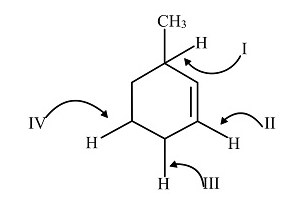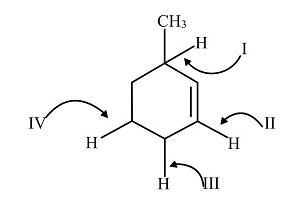Answer
405k+ views
Hint: The bond dissociation energy is defined as the amount of energy required to break the chemical bond formed between the two atoms in a chemical compound. The compound which forms a stable intermediate will be strong and high energy will be required to break the bond.
Complete step by step answer:
The covalent bond present between the two atoms is broken by two ways. It can be done either by heterolytic cleavage or by homolytic cleavage.
In homolytic cleavage, the product formed are radicals and the energy required for breaking the covalent bond is known as bond dissociation energy.
The homolytic bond dissociation energy is defined as the amount of energy required to break one mole of gases which are covalently bonded into radical pairs. The SI unit of bond dissociation energy is kJ/mol.

In the given compound, there are four hydrogen atoms bonded to carbon atoms by a covalent bond. But the C-H bond present at first position forms a stable intermediate by resonance formed by the radical due to the presence of methyl group which shows positive inductive effect, the double bond and the hyperconjugation due to five hydrogen atoms present in the ring.
Therefore, the C-H bond at (I) position requires minimum bond-dissociation energy to break the bond.
So, the correct answer is Option A.
Note: On comparing the primary C-H bond, secondary C-H Bond and tertiary C-H bond, the tertiary C-H bond requires less bond dissociation energy.
Complete step by step answer:
The covalent bond present between the two atoms is broken by two ways. It can be done either by heterolytic cleavage or by homolytic cleavage.
In homolytic cleavage, the product formed are radicals and the energy required for breaking the covalent bond is known as bond dissociation energy.
The homolytic bond dissociation energy is defined as the amount of energy required to break one mole of gases which are covalently bonded into radical pairs. The SI unit of bond dissociation energy is kJ/mol.

In the given compound, there are four hydrogen atoms bonded to carbon atoms by a covalent bond. But the C-H bond present at first position forms a stable intermediate by resonance formed by the radical due to the presence of methyl group which shows positive inductive effect, the double bond and the hyperconjugation due to five hydrogen atoms present in the ring.
Therefore, the C-H bond at (I) position requires minimum bond-dissociation energy to break the bond.
So, the correct answer is Option A.
Note: On comparing the primary C-H bond, secondary C-H Bond and tertiary C-H bond, the tertiary C-H bond requires less bond dissociation energy.
Recently Updated Pages
How many sigma and pi bonds are present in HCequiv class 11 chemistry CBSE

Why Are Noble Gases NonReactive class 11 chemistry CBSE

Let X and Y be the sets of all positive divisors of class 11 maths CBSE

Let x and y be 2 real numbers which satisfy the equations class 11 maths CBSE

Let x 4log 2sqrt 9k 1 + 7 and y dfrac132log 2sqrt5 class 11 maths CBSE

Let x22ax+b20 and x22bx+a20 be two equations Then the class 11 maths CBSE

Trending doubts
Fill the blanks with the suitable prepositions 1 The class 9 english CBSE

At which age domestication of animals started A Neolithic class 11 social science CBSE

Which are the Top 10 Largest Countries of the World?

Give 10 examples for herbs , shrubs , climbers , creepers

Difference between Prokaryotic cell and Eukaryotic class 11 biology CBSE

Difference Between Plant Cell and Animal Cell

Write a letter to the principal requesting him to grant class 10 english CBSE

Change the following sentences into negative and interrogative class 10 english CBSE

Fill in the blanks A 1 lakh ten thousand B 1 million class 9 maths CBSE




